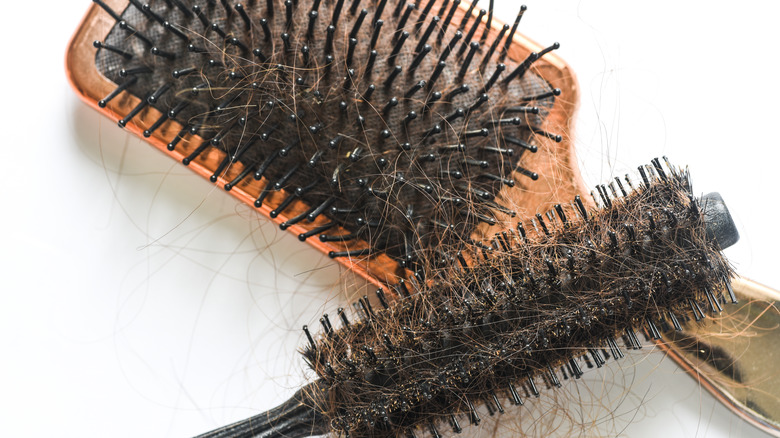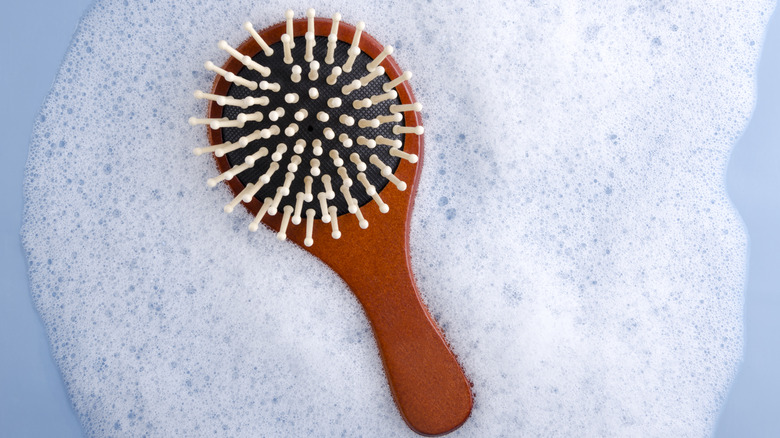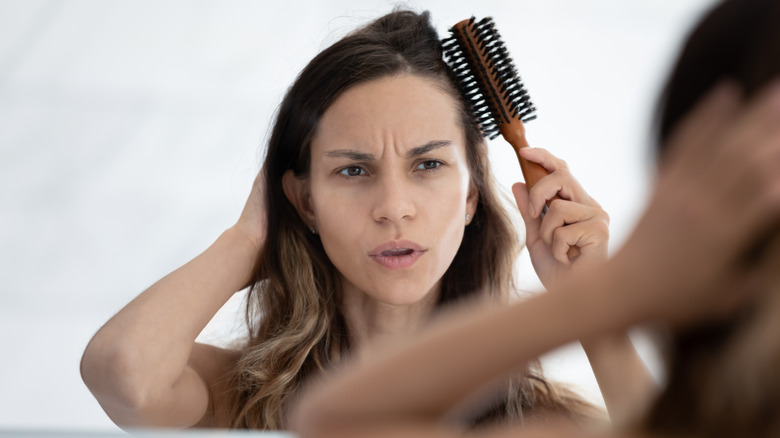None Of Us Are Cleaning Our Hairbrushes Enough. Here's How To Deep Clean Your Tools
Here's a piece of trivia you probably don't hear often: Your hairbrush is a cesspool of all kinds of muck. Oil, dead skin cells, bacteria, germs, and icky sticky residue of styling products are crammed in every nook and cranny of the same brush you reach out for every day. According to a study conducted by the University of Arizona, nearly 3,500 colonies of bacteria are found in every square inch of your brush, making it dirtier than your bathroom sink and your pet's food bowl. If that doesn't make your arm hairs stand up, we don't know what will.
You can assume that your hairbrush is dirty almost all the time, and the longer you prolong cleaning it, the more nastiness you're reintroducing to your head. Think about it: With each pass of the brush across your strands, you're also returning bacteria to them. "Brushing assists with distributing sebum," Bridgette Hill, a certified trichologist and hair science expert, shared with Insider. "Uncleansed and unsanitized brushes spread bacteria, recontaminate the scalp and hair with old product buildup, spread yeast and bacteria to the base of the hair fiber, leading to congestion and inflammation, which exacerbates any unwanted scalp symptoms and conditions."
There's no question — you should be cleaning your hairbrushes, and you should be cleaning them often. And while the process seems straightforward, the way you sanitize your brush depends on the type of bristles and handles.
The lowdown on ditching the dirt from your hairbrush
Just like how you clean your makeup brushes every few weeks, your hairbrushes must be cleaned with the same frequency. You likely use them every day, after all, and the more they pass through your locks, the more grime they accumulate. If you want to ensure the health of your hair and scalp, you must give your brush a deep clean now and then.
For brushes with synthetic handles and bristles, Real Simple notes that cleaning them involves soaking them in a solution comprised of warm water and roughly two teaspoons of shampoo. After yanking out the hair from the bristles, allow the brush to soak in the solution for around 10 minutes, and then rinse thoroughly under the sink. You can also use a tiny amount of baking soda in case any stubborn dirt is left on the surface. On the other hand, if your brush is made out of natural bristles, use a gentler shampoo, and even then, use only a single teaspoon. And if it so happens that the handle of your brush is crafted out of wood, it's also important to make sure not to include that part in the soaking to avoid damage.
Whatever you do, avoid drying your hairbrushes using a hair dryer so as not to ruin the bristles. Let them air dry and allow evaporation to do its thing instead. "Place your flat brushes upside down to allow the water to drain to prevent mold growth," renowned hairstylist Theo Pettway instructed Mbglifestyle.
When it's time to toss it in the trash
It happens to the best of us: we sometimes get attached to our hairbrushes since we use them multiple times a day. But whether you're using a swanky Denman or a brush you've picked up at the last minute from the checkout counter, you need to know when to let it go.
As it turns out, hairbrushes have a shelf life of six months to a year, and that still depends on the number of styling products you use regularly. The more often you use hairsprays, mousse, and gels, the more there is a need to swap out your brush frequently. Ghanima Abdullah, a cosmetologist and hair expert, told Byrdie that the most apparent sign of your brush needing replacement is when the bristles start fraying or go missing, or when it's getting progressively difficult to take out the gunk. "Missing bristles or prongs in a brush means work like it's designed to," she pointed out. "In the worst case scenario, the brush could catch in your hair and cause breakage." If the bed of your hairbrush breaks, that's a sign, too.
If you want to maximize your brush and postpone replacement, though, Marc Anthony, hairstylist and founder of Marc Anthony True Professional Haircare, shared with Women's Health is the secret lies in giving the bristles extra TLC. "Keeping them moisturized can help delay this from happening," he said. "Simply put some argan oil in the palm of your hand, then lightly run the brush through it, massaging gently."


